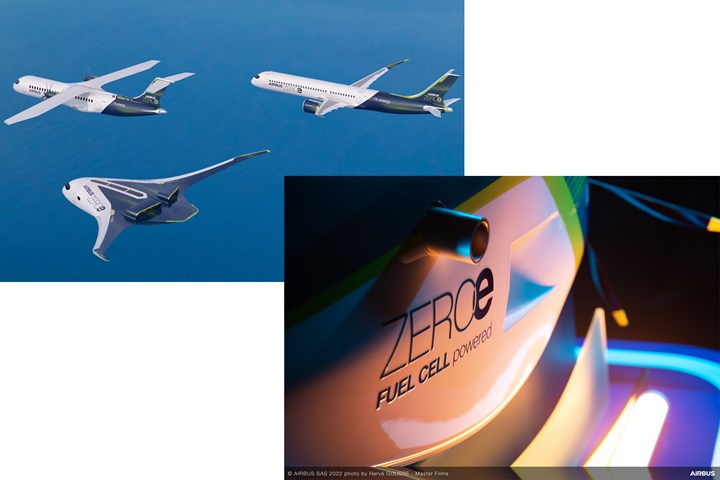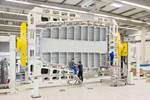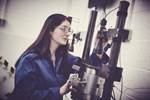Airbus opens ZEDC in Stade for H2 systems using composites
Zero-emission development center in Germany will target cryogenic liquid hydrogen tanks using lightweight carbon fiber-reinforced composites for proposed aircraft to enter service by 2035.

ZEROe concept aircraft and fuel cell engine. Photo Credit: Airbus
As reported in and , Airbus is opening a new ZEROe development center (ZEDC) in Stade, Germany to develop hydrogen technologies. target future zero-emission aircraft by Airbus that will use liquid hydrogen (LH2) instead of conventional fuel, proposed to enter into service by 2035. The ZEDC in Stade will focus on cost-effective lightweight hydrogen systems using fiber-reinforced composite materials, such as cryogenic LH2 tanks.
“This ZEDC will benefit from the broader ecosystem of composite materials research and development such as the Airbus subsidiary Composite Technology Center and the CFK NORD research center in Stade, as well as further synergies from space and maritime activities,” Airbus CTO Sabine Klauke says. Stade is also the site for production of Airbus’ composites-intensive vertical tail planes (VTP).
The team in Stade will cooperate with ZEDC working on metal tanks, especially those in Bremen, Germany, and Nantes, France. The work will include part design and manufacturing, as well as testing assembly methods. It will also contribute to the work at other ZEDC including in Madrid, Spain, and Filton, U.K.
Aviation Week notes that under the , the technology readiness level (TRL) for a metal LH2 tank was brought to TRL 4, while usually TRL 6 is required before launch of a product development. One of the STOHYC program’s partners, , is a specialist in conventional metal tanks and sees lighter weight composites as an option for the longer term. This view has also been expressed by hydrogen aircraft propulsion pioneer ZeroAvia. Airbus has in fact invested in ZeroAvia and agreed to collaborate on certification approaches for H2 power systems. The companies announced they would work on a number of critical technical areas, including H2 fuel storage, flight and ground testing of fuel cell propulsion systems, and development of H2 refueling infrastructure and operations.
Airliners.de adds that the ZEDC in Stade is supported by the German state of Lower Saxony and also through German funded projects like the LuFo aviation research program. It will also be linked to the government’s planned hydrogen innovation and technology center in northern Germany.
Related Content
-
Composite pressure vessels enable future energy storage
Q&A between Hexagon Purus, Infinite Composites and Hyosung USA delves into the future of H2 storage, including scalability and production goals, materials and application trends and other dynamics.
-
Development of a composite liquid hydrogen tank for commercial aircraft
Netherlands consortium advances cryogenic composites testing, tank designs and manufacturing including AFP, hybrid winding, welding of tank components and integrated SHM and H2 sensors for demonstrators in 2025.
-
Composites end markets: New space (2025)
Composite materials — with their unmatched strength-to-weight ratio, durability in extreme environments and design versatility — are at the heart of innovations in satellites, propulsion systems and lunar exploration vehicles, propelling the space economy toward a $1.8 trillion future.






